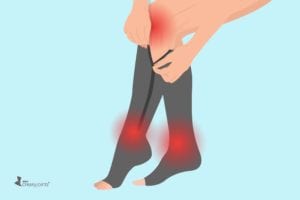Inflammatory arthritis or osteoarthritis that affects the legs or feet is not only painful, but can also limit your mobility. In order to stay active, some people living with arthritis have found that wearing special tight socks or stockings helps them feel better and allows them to move around easier. “I wear compression socks for my ankles and they help a lot,” arthritis patient Carolyn O. told us on Facebook. But just how effective are they?
How Compression Socks Work for Arthritis
Compression socks may lessen the symptoms of arthritis by applying mild pressure to affected joints, which can help with inflammation and swelling. “Fluid can build up in a joint affected by arthritis, which can cause swelling in the soft tissues surrounding the joint,” says Kristina Marie Quirolgico, MD, a physiatrist at the Hospital for Special Surgery in New York. “Compression socks or stockings work by keeping the swelling down.”
In addition, this reduced swelling “allows increased blood flow to muscles and joints,” says Cary Zinkin, DPM, a podiatric physician and spokesperson for the American Podiatric Medical Association (APMA).
Some arthritis patients we heard from said they found the socks did help calm their inflammatory symptoms. “Compression socks are very helpful on those days when my feet swell,” Elena K. told us on Facebook. “They help reduce the swelling thereby improving mobility.”
Stiff and swollen joints may also make feet feel numb or have lessened sensation, which can increase the risk of loss of balance and falls and difficulty walking. Compression socks may help add sensation back to your lower extremities. “They work to increase your feeling of proprioception [where your body is in space],” Dr. Zinkin says. Even people without arthritis, such as runners, use them for this purpose, he says.
Compression socks can also act as a brace to allow for more control and comfort when walking. “Compression stockings can ‘support’ the muscles and soft tissues around the joint, which helps pain management as well,” Dr. Zinkin says.
What Compression Socks Look Like
Compression socks can be short, covering just the ankle or calf, or come up to or even past the knee. “Compression stockings give the most pressure at the lowest point — ankles or feet — and gradually reduce pressure as you go higher on the leg, so they help drainage of blood back toward the heart,” Dr. Zinkin says. “They can be worn below the knee or at thigh length depending on the need.”
What type you wear will depend on where your arthritis is located. “Arthritis of the knee and ankle can benefit the most from compression socks because they’re easier to put on to cover those joints,” Dr. Quirolgico says. Compression socks may also be toeless; it’s a personal preference whether you like your toes in or out.
What Studies Say About Compression Socks for Arthritis
Unfortunately, there’s not a lot of scientific evidence to back up the use of compression socks for arthritis. “Most of the literature support its use to prevent deep vein thrombosis and for lymphedema control [swelling due to lymphatic system problems],” Dr. Quirolgico says. “There are not many studies that support its use for arthritis in particular, though it does provide more symptomatic relief in keeping the swelling down.”
Although there just aren’t many studies on compression socks yet (and the ones that have been done are inconclusive), many arthritis patients like them, so if you see a benefit, consider using them with your doctor’s approval. “Many people really enjoy the effects of wearing compression stockings,” Dr. Zinkin says.
Should You Wear Compression Socks?
In Dr. Zinkin’s opinion, “any type of arthritis can benefit from them, but people with rheumatoid arthritis or other inflammatory arthritis conditions might benefit more because anything that reduces inflammation around the joints and increases circulation can help improve the day-to-day condition and decrease pain,” he says. But people with osteoarthritis of the ankle or knee can benefit as well, Dr. Quirolgico says.
Follow your doctor’s directions, but you should probably only wear them during the day or when active. “If you wear compression stockings that are too tight overnight, you might restrict blood flow to the area, so it’s recommended to take them off at night and put them on again first thing in the morning,” Dr. Quirolgico says.
There are some people, though, who in particular should not wear compression socks without first getting cleared by their doctor. “Anyone with a history of diabetes, circulation problems, blood clots, skin ulcers, or certain other conditions should always consult their physician prior to obtaining compression stockings,” Dr. Zinkin says. The same goes if you’re experiencing severe swelling.
How to Wear Compression Socks
Your primary care doctor or a podiatrist may order the proper style and fit. However, “many of my patients have been professionally fit for maximum compression stockings, but they are extremely difficult for older patients to put on,” Dr. Zinkin says. “They often buy a lighter compression stocking without prescription from their local pharmacy, which at least enables them to put on in the morning, even if it’s not the optimal compression.”
Difficulty getting the socks on was by far their biggest drawback, according to arthritis patients we heard from. “Compression socks are too hard to put on,” Kris S. told us on Facebook. Elle F. agreed: “That is exactly why I can’t wear them. I have issues with strength in my wrists and hands.”
If you’re having trouble getting them on, you can get a special “stocking aid” online or at a pharmacy, which may help. It’s a frame that goes inside the stockings to help you get them on. It will also be easier to get them on if you make sure you’re completely dry after a shower and don’t have any lotion on your feet or legs.
Talk with your doctor about purchasing compression socks yourself, say, from Amazon or a local pharmacy. When selecting them, “patients should choose a stocking or sock based on the circumference of their leg,” Dr. Quirolgico says. “You don’t want to cut off circulation, but you also don’t want the sock to fall down because it’s too loose.”
Also, “if you notice that the swelling at the knee is just being pushed up to the thigh from wearing knee high compression socks, then you should probably switch to using a thigh-high compression sock,” Dr. Quirolgico says.
Types of Compression Socks to Try
Dr. Zinkin recommends brands that have received the APMA seal of approval, including:
- Dr. Scholl’s Compression Socks: Dr. Scholl’s offers many different styles of compression socks, from low ankle versions to those that go up to or over the knee.
- Dr. Comfort Compression Socks: Offered in tencel (rayon) material or sheer, like pantyhose, these socks are reviewed as being not too tight, not too loose — just right.
- Sockwell Compression Socks: In addition to providing gentle compression, these compression socks come in fun colors and patterns to liven up your outfits. “I used Sockwells for a couple years daily, and now mostly with flares, as otherwise my legs are doing better,” Robin K. told us on Facebook.
Not Sure What’s Causing Your Foot or Knee Pain?
Check out PainSpot, our new pain locator tool. Answer a few simple questions about what hurts and discover possible conditions that could be causing it. Start your PainSpot quiz.






